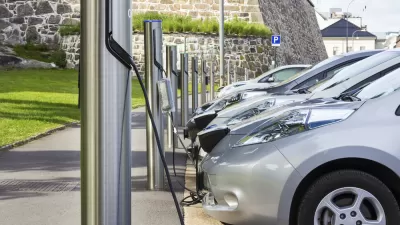Even as auto manufacturers roll out bigger, better technology for electric vehicles, high production costs – particularly from battery manufacturers – are keeping sales figures low, Tim Fernholz reports.
Last week, American and European automakers showcased a cutting-edge electric vehicle charging system – to be adopted as the new standard – that can top up the "tank" in under 20 minutes (that's up to ten times faster than existing systems).
"The initiative represents a step toward an electrified automotive future, akin to agreeing on standard-sized railroad tracks to extend rail networks across the country," writes Fernholz. "But there's still a major obstacle standing in the way of mass adoption of electric cars: battery technology, and the price that comes with it."
Slated for release this spring, Ford's fully-electric Focus retails at $32,450 after a hefty federal tax rebate – that's over 75% more than the $18,300 price tag on the standard model, enough to fill up the tank almost 300 times at $4/gallon.
While the company aims to lure the younger generation of drivers with hi-tech entertainment systems and a green ethos, that may not be enough to overcome the sticker shock. Mike Tinskey, director of global vehicle electrification at Ford, sees battery prices as the greatest roadblock to hitting the right price point for the market.
"While part of the problem is technological, Tinskey points to economics as the central challenge. 'In my opinion, it's scale-how do you prime the pump?' he says. 'You really need to get scale at these battery plant manufacturing facilities.'"
FULL STORY: What's Killing the Electric Car? The Price of Batteries

Alabama: Trump Terminates Settlements for Black Communities Harmed By Raw Sewage
Trump deemed the landmark civil rights agreement “illegal DEI and environmental justice policy.”

Study: Maui’s Plan to Convert Vacation Rentals to Long-Term Housing Could Cause Nearly $1 Billion Economic Loss
The plan would reduce visitor accommodation by 25% resulting in 1,900 jobs lost.

Why Should We Subsidize Public Transportation?
Many public transit agencies face financial stress due to rising costs, declining fare revenue, and declining subsidies. Transit advocates must provide a strong business case for increasing public transit funding.

Paris Bike Boom Leads to Steep Drop in Air Pollution
The French city’s air quality has improved dramatically in the past 20 years, coinciding with a growth in cycling.

Why Housing Costs More to Build in California Than in Texas
Hard costs like labor and materials combined with ‘soft’ costs such as permitting make building in the San Francisco Bay Area almost three times as costly as in Texas cities.

San Diego County Sees a Rise in Urban Coyotes
San Diego County experiences a rise in urban coyotes, as sightings become prevalent throughout its urban neighbourhoods and surrounding areas.
Urban Design for Planners 1: Software Tools
This six-course series explores essential urban design concepts using open source software and equips planners with the tools they need to participate fully in the urban design process.
Planning for Universal Design
Learn the tools for implementing Universal Design in planning regulations.
Smith Gee Studio
Alamo Area Metropolitan Planning Organization
City of Santa Clarita
Institute for Housing and Urban Development Studies (IHS)
City of Grandview
Harvard GSD Executive Education
Toledo-Lucas County Plan Commissions
Salt Lake City
NYU Wagner Graduate School of Public Service




























